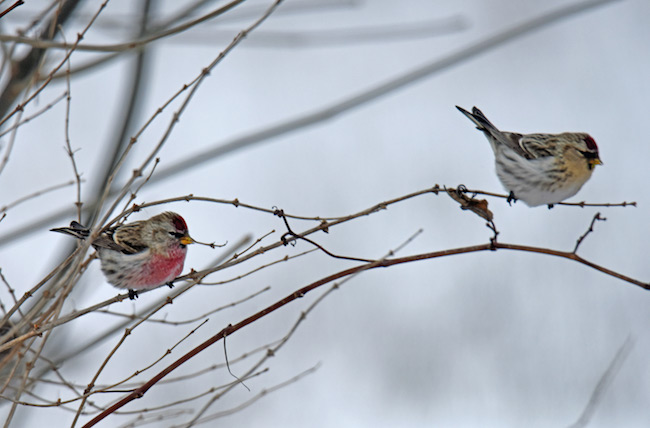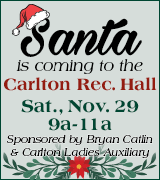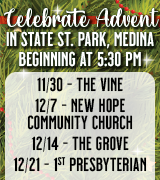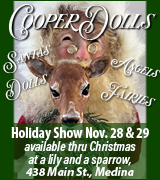Lots of diversity in annual Christmas Bird Count at Oak Orchard Swamp
New record highs for Northern Saw-whet Owl, Common Raven, Brown Creeper, Carolina Wren, Winter Wren and European Starling

Photo by Celeste Morien: This photo of a Common Redpolls was not taken on count day of Dec. 28, which was very windy.
By Celeste Morien, Count Compiler for Oak Orchard Swamp Christmas Bird Count
SHELBY – The numbers are in and it was another successful Oak Orchard Swamp Christmas Bird Count.
On Dec. 28, 31 volunteers participated in the 53rd annual Oak Orchard Swamp Christmas Bird Count. The National Audubon Society, in collaboration with the U.S. Fish and Wildlife Service, sponsor Christmas Bird Counts annually throughout the country and beyond in the Americas. Each count consists of a tally of all birds seen within a 15-mile diameter circle on one day during a 15-day period at the end of December and the beginning of January. Audubon Christmas Counts provide valuable information on the range expansion or narrowing of wintering bird populations and have been taking place for 120 years.
The Oak Orchard Swamp Count Circle
The circle center for the Oak Orchard count is the point at which the Genesee-Orleans County line crosses Route 63. The 15-mile diameter circle includes the Iroquois National Wildlife Refuge, Oak Orchard and Tonawanda State Wildlife Management Areas, the Tonawanda/Seneca Native American Reservation, the Townships of Alabama and Shelby, the villages of Indian Falls, Medina and Wolcottsville and portions of Middleport and Oakfield.
Weather Factors
Weather can make or break the day for our observers, but we forge ahead! Count hours were cold and wet, with a low of 27F and high of 39F. The early morning began with rain and winds from the south at 11 MPH, which then began gusting throughout the afternoon from the WSW at 16 -21 MPH, making the temperatures essentially feel 10 degrees colder. By afternoon, birding was essentially precipitation free. Late morning and afternoon visibility was good.
Observers
Our 31 intrepid observers went afield in 23 parties from 6:15 a.m. until 6:45 p.m. These folks volunteer to attend from as far away as Rochester and Buffalo, and even with the Covid-19 restrictions in place, persevered in their determination to ensure that the 2020 count would become another accurate contribution in the collection of scientific information about wintering bird populations.
In 106.25 total hours, observers covered 25.75 miles on foot and 535.5 miles by car, which included 37 hours on foot and 69.25 hours by car! Two observers counted birds at home feeders. Participants also clocked 9 nocturnal hours and 39.25 miles searching for owls.
In total, these awesome observers tallied 73 species and 20,843 individual birds! As the compiler, I say thank you all and thank you again to Douglas Beattie, Elaine Dart, Don Bemont, Daniel Rosentreter, Thomas Morien, Garner Light, Judy Light, Rory Kuczek, Paul Hess, Kathryn Brenner, Janie Mellas, Robert Buckert, Jules Wagner, Greg Lawrence, William Wolanske, Denise Appleby, Pat Martin, Kim Hartquist, Bev Seyler, Bob DeLeon, Jennifer Caughel, Donna DeLeon, Emma DeLeon, Mike Vickner, Mike Galas, Gerry Rising, Chuck Mitchell, Heidi Kennedy, Tad Gerace, Christopher Hollister and Iroquois NWR and the NYS DEC.
Winter Diversity
Counters commented on good diversity overall with a few exceptions, such as the lack of waterfowl in the region because of the freeze in early December. Still, we had all three swan species and a smattering of waterfowl. Lack of snow cover on the ground and heavy winds made finding birds at roadside difficult, but there were birds to be found for those who had the opportunity and spent time walking. With a total lack of snow cover, participants reported that birds were difficult to see in fields and were not present at the roadsides. Wished-for irruptive species (those that visit in winter from the boreal forest when cone crops there are low) such as Evening and Pine Grosbeak were not found although they have been seen in other areas of the state, and even in our circle this fall. Irruptive species we did find: a few Pine Siskins, Common Redpolls, which have shown a recent uptick and Red-breasted Nuthatches.
Highs and Lows
Notable highest counts ever: Northern Saw-whet Owl, Common Raven, Brown Creeper, Carolina Wren, Winter Wren and European Starling.
Gerry Rising found the Saw-whet Owls and stated he’d never had an experience quite like this one in his many years of watching birds. Both owls flew out of conifers in response to a recording played in the early morning.
Common Ravens are increasing their presence in the Great Lake plains area, resulting in a total of five of these fascinating and intelligent corvids on count day. Fox Sparrow was the single “new to the count” species this year; Janie Mellas, one of our many sharp-eyed participants, found it lingering on the Iroquois Refuge. A single Red-winged Blackbird was recorded as a new low count. Count week birds seen in the three days before or after the count date, but not on the actual count date, were Sandhill Crane and Northern Pintail.
The Friends of Iroquois, Inc. usually sponsor our evening refreshments at the refuge, but because of the Covid-19 pandemic that was not possible. The INWR Staff was still able to contribute time and effort in covering the refuge areas. The NYS DEC staff also volunteered to report birds while on duty and conducted their winter raptor survey on count afternoon. Many thanks go out to everyone who participated! A list of species follows.
The 2021 Count
We rely on volunteer support every year to continue this important tradition. I might add that for next year, I welcome any homeowner in the circle who wants to count birds at their feeding station to contact me through the NYS Ornithological Association (NYSOA) or Buffalo Ornithological Society websites two weeks before the count. We also welcome permission for counters to access any private property trails or field edges within the circle for walking.
Look for the count date to be announced by mid-November and please put us on your calendar!
A list of species observed at the 2020 count includes (The asterisk represents an all-time high):
- Mute Swan,2
- Tundra Swan, 21
- Trumpeter Swan, 4
- Cackling Goose, 6
- Canada Goose, 3,367
- American Black Duck, 18
- Mallard, 116
- Northern Shoveler, 35
- Common Merganser, 10
- Ring-necked Pheasant, 3
- Wild Turkey, 59
- Great Blue Heron, 3
- Northern Harrier, 12
- Sharp-shinned Hawk, 3
- Cooper’s Hawk, 6
- Bald Eagle, 17
- Red-tailed Hawk, 57
- Rough-legged Hawk, 2
- Ring-billed Gull, 115
- Herring Gull,11
- Rock Pigeon (Feral Pigeon), 223
- Mourning Dove, 173
- Eastern Screech-Owl, 5
- Short-eared Owl, 6
- Northern Saw-whet Owl, 2*
- Red-bellied Woodpecker, 71
- Yellow-bellied Sapsucker, 1
- Downy Woodpecker, 78
- Hairy Woodpecker, 17
- Northern Flicker, 19
- Pileated Woodpecker, 6
- American Kestrel, 3
- Merlin, 1
- Northern Shrike, 2
- Blue Jay, 129
- American Crow, 287
- Common Raven, 5*
- Horned Lark, 106
- Black-capped Chickadee, 426
- Tufted Titmouse, 30
- Red-breasted Nuthatch, 12
- White-breasted Nuthatch, 69
- Brown Creeper, 20*
- Carolina Wren, 5*
- Winter Wren, 3*
- Golden-crowned Kinglet, 13
- Eastern Bluebird, 31
- Hermit Thrush, 1
- American Robin, 260
- Northern Mockingbird, 1
- European Starling, 12,324*
- Cedar Waxwing, 2
- Snow Bunting, 275
- Yellow-rumped Warbler, 3
- American Tree Sparrow, 294
- Dark-eyed Junco, 737
- White-crowned Sparrow, 13
- White-throated Sparrow, 43
- Savannah Sparrow, 2
- Song Sparrow , 19
- Swamp Sparrow, 11
- Northern Cardinal, 170
- Red-winged Blackbird, 1
- Brown-headed Cowbird, 12
- House Finch, 41
- Common Redpoll, 30
- Pine Siskin, 2
- American Goldfinch, 236
- House Sparrow, 454
Total individuals, 20,843
Total species, 73







































































